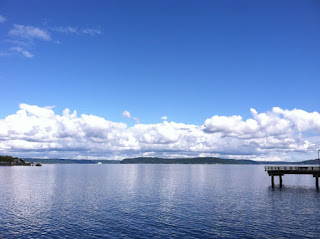Excess nutrients are hurting Puget Sound
 |
Puget
Sound is the nation’s second largest estuary
and faces many challenges, including
population
growth, development, and pollution.
|
To improve and protect water quality in Puget Sound, we are focused on finding solutions for improving levels of dissolved oxygen in Puget Sound. Domestic wastewater treatment plants (WWTPs), or sewage treatment plants, are a major human source of nutrients to Puget Sound and are significantly contributing to low oxygen levels (read our Salish Sea Modeling reports for more info). With our region’s growing population, and recognizing that WWTP improvements to limit nutrients will take time, we need to start work now to protect and restore Puget Sound. To keep Puget Sound clean, Ecology must require WWTPs to control nutrients and we have made a preliminary determination to use a General Permit to accomplish this.
Controlling nutrients from WWTPs with a Puget Sound Nutrients General Permit
 |
Wastewater
is the water that leaves our businesses and
homes from sources like sinks,
showers, and toilets.
|
- New General Permit: Require nutrient limits for WWTPs that discharge to Puget Sound (in addition to their existing individual permits that cover other limits).
- Individual Permits: Include nutrient limits in each individual permit for WWTPs that discharge to Puget Sound.
We have made a preliminary determination that a general permit is the best tool for addressing excess nutrients in Puget Sound. A Puget Sound Nutrients General Permit would:
- Create a single coordinated public engagement process, allowing more stakeholder collaboration during permit development.
- Place WWTPs on a similar schedule instead of staggered permit requirements based on different individual permit schedules.
- Provide a foundation for communities to work together to achieve nutrient controls across Puget Sound.
General vs. Individual permits
All wastewater treatment plants require a water quality permit to operate, specifically to discharge to surface water. We use permits to limit pollutants that may enter our waterways. Both types of permits (general and individual) are issued on 5-year cycles, allowing us to adapt requirements in response to new information and technologies.A general permit covers a group of dischargers that have similar qualities within a similar region. We can use a general permit to satisfy any or all state and federal water quality permit requirements. General permits are a cost-effective way to regulate numerous dischargers under a single permit. It allows us to hold a single permit development and implementation process per 5-year cycle for all the facilities together. This process includes stakeholder and permittee engagement.
The other permitting option is using individual permits, which we tailor to individual facilities. We issue each individual permit on independent schedules consistent with facility-specific permit renewal and reissuance dates, and a public comment process.
How would a Nutrients General Permit work?
A Puget Sound Nutrients General Permit would apply to nearly 70 WWTPs that discharge to marine and estuarine waters of Puget Sound. A Nutrients General Permit would focus only on controlling nutrients. All WWTPs already have individual permits that regulate other pollutants. Therefore, WWTPs would have two permits.We are at the earliest stage of a general permit process and it is too soon to know the exact permit conditions. If we move forward with the general permit, the permit development process will determine:
- Which WWTPs will be included in the general permit.
- How to cap nutrient loading.
- What planning will be needed to meet nutrient reduction targets, starting with optimizing nutrient reduction with existing infrastructure, the feasibility of infrastructure upgrades, or other water quality improvement efforts.
Public comment period for the Preliminary Determination to Develop a Nutrients General Permit
We are accepting comments from Aug. 21 until Oct. 21, 2019 on our preliminary determination to develop a Nutrients General Permit. You may submit comments online.We welcome your feedback on whether a general permit is the appropriate tool to control and reduce nutrients in discharges from WWTPs to Puget Sound. This public comment period is also an opportunity to provide us other relevant information about WWTPs and Puget Sound water quality.
For more information on the nutrients problem, the permit proposal, and how to comment, read our focus sheet. We do not currently have draft permit language. However, if we move forward with a general permit, we will prepare draft permit language and hold another public comment period.
You can find all of this information and additional materials on our General Permits webpage.
Other States with general permits for nutrients
Other states have used general permits to reduce the impacts of nutrients on their coastal waters. In March, our Puget Sound Nutrient Forum hosted water quality experts from Chesapeake Bay and Long Island Sound to hear about their general permit process and other strategies they used to reduce nutrients in their waterways. Both of these estuaries have experienced success in cleaning up excess nutrients in their waterways and are on their way to improved water quality and restored marine habitats. Read our previous blog to learn more about how other states manage nutrients in their coastal estuaries.What else is Ecology doing to reduce nutrients?
 |
The Nutrient Forum, a large public advisory
committee, meets regularly to provide input
on how to reduce human sources of nutrients.
|
More information:
To receive email updates about this potential general permitting effort, register for the Nutrients Permit listserv.To receive updates on the broader Puget Sound Nutrient Reduction Project, register for the Puget Sound Nutrient Reduction listserv or visit www.ecology.wa.gov/PSNRP.
By Kelly Ferron, Water Quality Program

No comments:
Post a Comment